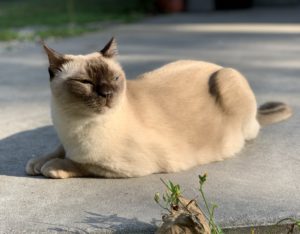Help For Super Finicky Cats

Some cats become super finicky, especially as they get older. Just this week I had two different people tell me their cat will only eat one type of food. One brand, one flavor. Unfortunately, the food these cats like is either hard to source or is being discontinued by the manufacturer. Now their owners are in a panic! What do you do if your cat’s one favorite food is no longer available?
Become a good detective when your cat is super finicky
The first thing I recommend is ruling out any underlying health condition. Secondly, determine your cat’s preferences.
- What kind of texture does your cat’s food have? Morsels, pate’, lots of gravy, shredded, chunks, etc.?
- Is there a specific smell to it?
- Does the cat like this particular protein type/s in a treat?
- Did the cat used to have other favorite proteins?
- Is the food wet or dry?
- Is the food cold or room temp? Most cats don’t like cold food…try warming it up with a hot water bath in the sink. Never microwave!
Tips for introducing other foods
Based on the answers to these questions here’s what I recommend doing next.
- Try another SKU of the same brand with the “favorite protein” plus one other protein.
- If the cat has a favorite treat, sprinkle it over the “new” food.
- Put the “favorite food” and another food side by side in the food bowl so the cat can get accustomed to smelling something different.
- Mix the favorite food with a tiny portion of another food.
- If you free-feed your cat with an all day buffet pick it up, and put your cat on a meal schedule. Hunger is your friend!
In an interview with Dr. Karen Becker, DVM, Dr. Joseph Bartges of the University of Georgia College of Veterinary Medicine, was asked about cats who get “stuck” eating one thing.
It can be tricky because cats are cats,” says Dr. Bartges. “Mix the old and the new food together if possible, so that they can’t pick it out. If you don’t mix them well, cats are really good at picking out the old food and not touching the new. You can try adding a little water, which makes the foods easier to mix together. Or add chicken, beef, or turkey bone broth. If they’re used to a chicken-based food, try using chicken broth to give the new food the flavor of chicken.”
He also suggested that having them hunt for their food or using interactive toys and puzzle toys can also motivate them. “Keeping them active and tapping into their hunting instinct can get them motivated to try something new,” he explains. This can help keep them engaged and motivated to try new things.
Additional strategies to consider for super finicky cats
If your cat still refuses to eat anything besides the “favorite,” there are still other things to consider.
- Using an animal communicator to ask your cat specifically why she will only eat one food. Valuable insights can also be learned about your cat’s preferences. The communicator can also ask your cat for its cooperation in eating other foods as well as explain why this is so important or necessary.
- Muscle testing can determine if your cat has food sensitivities to particular proteins or other ingredients in the food. It can also reveal if wet food is a stressor or an energetic “block.”
- Your cat may have an addiction to sugar if it will only eat dry food. Sugar, the emotion “obsession”, the opioid receptor site, gustatory cortex and gustatory cells in the brain will all resonate with imbalance collectively when muscle tested. The gustatory cortex and cells are the areas that govern sensation of tastes; the opioid receptor site controls addictive behaviors, hence the emotion “obsession”.
The importance of nutritional diversity
If your cat is “stuck” on a single food it’s time to explore the underlying causes. Every protein has a different nutrient profile; therefore, providing a variety of foods gives them a broader range of vitamins, minerals and nutrients their bodies need. It also helps reduce the likelihood of developing food sensitivities, too.
Dr. Bartges was asked about the importance of nutritional diversity when feeding cats in his interview with Dr. Becker.
“I think it’s really important…There’s not a lot of scientific data to back it up but I think it’s important for them to eat a variety of foods. I think it does a couple of things. You want variety in textures, and you want variety in flavors. Cats tend to be good at getting locked into a food. And then if you need to change the food, it becomes a real headache or impossible.
By giving them a variety of things, again, it accomplishes two things. One is it gives them familiarity with lots of different textures. It’s a mix of textures of commercially available canned and dry foods, as well as treats, plus homemade treats and foods.
The other advantage of a variety of foods is if, for example, there is a cat food, a group of foods, or a specific ingredient that has been recalled for some reason, when we offer a variety of foods, it dilutes that potential adverse effect down.
Need help with your cat’s picky palette? An Optimal Cat Health Analysis utilizes muscle testing to identify and address stressors in the body as well as customized, holistic recommendations to improve your cat’s health and wellbeing.


